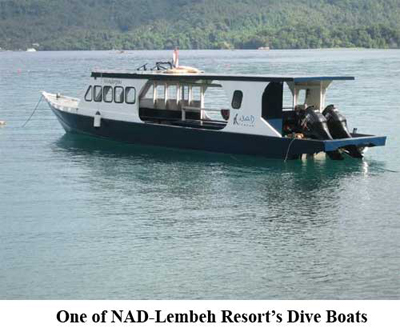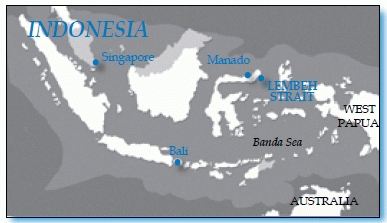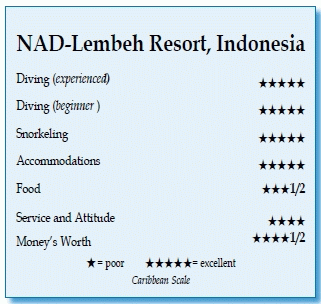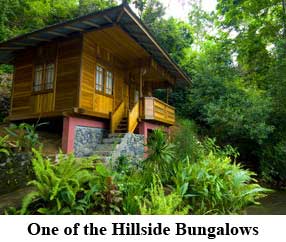NAD-Lembeh Resort, IndonesiaContents of this Issue: Are Lionfish Hunts Making It Harder to Kill Them? Costa Rica, Montserrat, St. Eustatius . . . Divemasters Wanted: You Pay Us to Work Here Help a Wounded Warrior Learn How to Dive Florida Court Rules: Divers Must Sign the Right Waiver Stuff to Soothe Your Soul During a Hellish Trip What’s the Price of an Air Fill? Pretty Cheap Editorial Office: Ben Davison Publisher and Editor Undercurrent 3020 Bridgeway, Suite 102 Sausalito, CA 94965 great critters, great people, great prices from the July, 2014 issue of Undercurrent
Dear Fellow Diver: When going to the ends of the dive world -- and Indonesia is -- I make sure Itravel to the best dive facility with the best guides. Having visited Bali, Komodo and Raja Ampat on extended prior trips, I would start this trip in Lembeh (pronounced "Lem-bay"), about a 90-minute drive from the Manado airport, followed by a short boat ride. I was in search of muck diving and Lembeh, with a well-protected, narrow channel between it and the mainland, has world-renowned critter diving. It would take me 43 real hours to get there and almost two kilobucks in airfare, so I researched the 13 dive resorts in the Lembeh Straits and finally selected NAD-Lembeh Resort, priced at $150 a night, including diving.
The next morning, four Taiwanese divers with their guide joined Stenley, me, and my new dive buddy, Andreas, whom I had met the night before. This young German not only carried a great camera setup, but also knew how to find critters. I was traveling by myself, so I felt lucky to find such an experienced dive buddy. After another short ride, I backrolled into the water and descended 70 feet to a cockatoo flounder. After easing away, I saw the Taiwanese photographing other critters without stirring a speck of sediment. They were so sharp-eyed that many times they pointed out "finds" to their guide as well as to us fellow divers. I usually end a dive with plenty of air to spare, but these guys were so good, I switched to a 100 cu-ft. tank to log dives as long as 85 minutes without worrying I might miss something if I ran low on air. NAD-Lembeh provided a guide for every four people (I was by myself or with one or two others for all of my 24 dives), and separated dive groups in order to minimize the wait to see the latest "find" and hold down the silt. Nearly every diver had a housed SLR camera with video and red modeling lights to frame the critters. NAD limited each diver to three minutes viewing or five photographs -- a great idea because too often I've seen photographers take dozens of shots of the same critter, oblivious to all around them, then stir up silt when they chase after the next critter. Having photographed for 35 years, I recently downsized (literally) to a housed Olympus Pen Mini and shot videos and a few stills. I missed my macro capabilities -- if you're a serious photographer, you will need a true macro lens. While I had requested and been promised Stenley for my guide, a professional photographer arrived at the resort on my third day, so Stenley joined the professional and I was assigned to a good but less-experienced guide. I've noticed that at many places, the more money your photography gear is worth, the better the guide you're assigned. After a few days, I requested they make good on their promise, but oddly, they "solved" the problem by taking Stenley off all dives (rest time) and leaving me with my guide. Regardless, my guide spent every minute of every dive looking for critters, so what's to complain about?
Tea, ice and coffee or espresso from a Krups grinder and coffee machine were available 24 hours. Breakfast was eggs any way I liked, served with fresh homemade bread, meat and cereal. Lunch and dinner usually had fish, a meat, veggies, bread, juice and a light desert. Indonesian and Asian preparations as well as "western" cuisine were options at all meals. I especially enjoyed the Indonesian dishes, but with six weeks' total travel in Indonesia, I didn't let a good hamburger go uneaten when it was offered. Vegetarians were easily accommodated. Good food in the open-air dining room with a beautiful view, mild temperatures and great staff and fellow guests made meals something to look forward to. Sergio, the resort manager, always delivered, whether I asked him for a fish ID or noted a burned-out light bulb. Both Simon and Sergio are excellent professional photographers and eager to share photo tips and fix equipment. They and Zee always ate with us, often asking if everything was OK. I can't imagine that anyone could leave NAD with an unresolved complaint. The four dive boats had 12 slots each. On my third day, exactly 12 guests were diving, but the resort still took two boats, four guides and six crew. We rarely saw another dive boat. The crew took care of all the equipment and tank changes, and helped divers climb aboard. Shore dives are reportedly "not bad," but with three dives and a night dive, I was already getting five hours underwater daily, so I didn't test those waters. Indonesia law mandates that all employees below top management must be Indonesians, so language limitations meant briefings were limited and almost always the same: Dive to rubble or sand at 60 to 90 feet, move to rubble or sand slope at 30 to 60 feet and coral above 30 feet (unless in a harbor). I never dove below 100 feet -- it just wasn't necessary -- but those who chose to dive their own profile or solo did so without scolding. I often saw mimic, long-arm and wonderpus
octopuses on the same dive, and ev For divers staying longer, there are two excellent wreck dives in the channel, one at 80 feet and a WWII freighter at 100 feet. At both ends of Lembeh Strait are reportedly excellent reef dives with even richer coral, schools of larger fish, pelagics, etc. But muck diving is the draw, as characterized by one couple who have been coming for two months each year for five years and have only done muck dives. I've made about 1,400 dives worldwide, and compared to the other divers there, I was roughly in the middle of the pack in terms of experience. One of the NAD "regulars" was a retired, 75-year-old doctor who, while physically limited, had a mind and memory so sharp that I found myself seeking him out for my unknown critter IDs. One recommendation is that you might be wise to save Lembeh until you've done a fair amount of Pacific diving. It's not about coral, reefs or fish, at least not big fish. It's about critters. It takes a special diver -- one with a good camera -- to appreciate just how special this place is. -- P.R.
|

I want to get all the stories! Tell me how I can become an Undercurrent Online Member and get online access to all the articles of Undercurrent as well as thousands of first hand reports on dive operations world-wide
| Home | Online Members Area | My Account |
Login
|
Join
|
| Travel Index |
Dive Resort & Liveaboard Reviews
|
Featured Reports
|
Recent
Issues
|
Back Issues
|
|
Dive Gear
Index
|
Health/Safety Index
|
Environment & Misc.
Index
|
Seasonal Planner
|
Blogs
|
Free Articles
|
Book Picks
|
News
|
|
Special Offers
|
RSS
|
FAQ
|
About Us
|
Contact Us
|
Links
|
3020 Bridgeway, Ste 102, Sausalito, Ca 94965
All rights reserved.

 I arrived late afternoon and hadn't even unpacked
when I was asked by other guests to join a night dive
-- some had just arrived from 30-plus hour trips, so
why not? Stenley, the "top" guide (whom I requested in
advance), helped me get my equipment ready. After a five-minute
ride on the fast wooden skiff, we reached the AER
Parang I dive site. I backrolled into 82-degree water and
descended with Stenley. Within 60 seconds, I was staring
at a coconut octopus. Then Stenley pointed out a bobtail
squid. Then a bright
red reef octopus. Then
a six-inch umbrella
shell nudibranch. And
a juvenile scorpionfish,
a cluster of
squid eggs inside a
coconut shell, a small
frogfish waiving its
bait. And so it continued.
Whenever I
looked up from my current
critter, Stenley
had another waiting:
a small yellow frogfish, two flounders playing
(mating?) in the sand, a
foot-long, free-swimming banded
pipefish, a seemingly unafraid
golden jawfish, a crocodile
flathead, and shrimp everywhere.
For the entire 70-minute dive, I
never waited more than a minute
to discover or be directed to
something unique. Then, an easy
climb up the sturdy ladder, and
I was met with a dry towel and
hot tea and snacks.
I arrived late afternoon and hadn't even unpacked
when I was asked by other guests to join a night dive
-- some had just arrived from 30-plus hour trips, so
why not? Stenley, the "top" guide (whom I requested in
advance), helped me get my equipment ready. After a five-minute
ride on the fast wooden skiff, we reached the AER
Parang I dive site. I backrolled into 82-degree water and
descended with Stenley. Within 60 seconds, I was staring
at a coconut octopus. Then Stenley pointed out a bobtail
squid. Then a bright
red reef octopus. Then
a six-inch umbrella
shell nudibranch. And
a juvenile scorpionfish,
a cluster of
squid eggs inside a
coconut shell, a small
frogfish waiving its
bait. And so it continued.
Whenever I
looked up from my current
critter, Stenley
had another waiting:
a small yellow frogfish, two flounders playing
(mating?) in the sand, a
foot-long, free-swimming banded
pipefish, a seemingly unafraid
golden jawfish, a crocodile
flathead, and shrimp everywhere.
For the entire 70-minute dive, I
never waited more than a minute
to discover or be directed to
something unique. Then, an easy
climb up the sturdy ladder, and
I was met with a dry towel and
hot tea and snacks. Before I arrived, I thought
I would be diving an underwater
garbage dump that had unusual
critters because nothing else could live there. True, there is some trash from
the villages and commercial ships in Lembeh straits, but the trash serves as
critter housing and was not a distraction. And there were healthy coral reefs
at many sites -- 100 feet of lettuce coral, small walls filled with soft corals,
sea fans with pigmy seahorses, barrel sponges big enough to crawl inside,
schools of juvenile fish -- but a shortage of big fish.
Before I arrived, I thought
I would be diving an underwater
garbage dump that had unusual
critters because nothing else could live there. True, there is some trash from
the villages and commercial ships in Lembeh straits, but the trash serves as
critter housing and was not a distraction. And there were healthy coral reefs
at many sites -- 100 feet of lettuce coral, small walls filled with soft corals,
sea fans with pigmy seahorses, barrel sponges big enough to crawl inside,
schools of juvenile fish -- but a shortage of big fish. NAD-Lembeh resort is beautifully set in a small cove at the foot of a steep
hill. There are 10 motel-style beachfront rooms and four hillside bungalows.
Simon, a German who's lived in Indonesia for years, and his wife, Zee, a native
Indonesian, bought the resort five years ago. They added a camera room with 10
individual booths plus counters, rebuilt the outdoor dining area (with a beautiful
view of the bay and mainland volcanic mountains), refurbished the rooms and added the four bungalows. With improvements
still ongoing, they're on their
way to creating the best facility and
dive operation in Lembeh. My private
hillside bungalow was just a short walk,
had a great view and was a steal at
only a couple of hundred dollars a week
more than the smaller beach rooms. A
wooden front deck led into my spacious
room with a king-sized bed with mosquito
netting, an armoire, a desk and a large
private bath. Room #10 and bungalow #1
have the best views. Sheets and towels
were changed every two days, or daily
if I asked.
NAD-Lembeh resort is beautifully set in a small cove at the foot of a steep
hill. There are 10 motel-style beachfront rooms and four hillside bungalows.
Simon, a German who's lived in Indonesia for years, and his wife, Zee, a native
Indonesian, bought the resort five years ago. They added a camera room with 10
individual booths plus counters, rebuilt the outdoor dining area (with a beautiful
view of the bay and mainland volcanic mountains), refurbished the rooms and added the four bungalows. With improvements
still ongoing, they're on their
way to creating the best facility and
dive operation in Lembeh. My private
hillside bungalow was just a short walk,
had a great view and was a steal at
only a couple of hundred dollars a week
more than the smaller beach rooms. A
wooden front deck led into my spacious
room with a king-sized bed with mosquito
netting, an armoire, a desk and a large
private bath. Room #10 and bungalow #1
have the best views. Sheets and towels
were changed every two days, or daily
if I asked. en
blue-ring octopuses. I eventually quit videoing
them to enjoy just watching the mimic
mimic the wonderpus, a cuttlefish or even a
flounder. Color changes were remarkable. On
one dive, I saw an eel slither tail-first
into a hole and come out with a big worm --
maybe a ribbon eel -- in its mouth. Small
cuttlefish were on every dive, and porcupinefish
were everywhere. Various anemones were
everywhere, too, home to several different
kinds of anemonefish, many aggressively protecting
their recently-laid eggs. Dive days at a special Mandarinfish site with uncharacteristically brave Mandarinfish are
rotated among the 13 resorts. There was virtually no current, and I had 82-degree
water temperatures and 30- to 70-foot visibility on every dive (it's better in
the non-rainy season). The warm waters may predispose some divers to external ear
canal infections. I wore a thin hood, more to protect my ears from the bubbles
constantly "washing" out my protective ear wax than for warmth.
en
blue-ring octopuses. I eventually quit videoing
them to enjoy just watching the mimic
mimic the wonderpus, a cuttlefish or even a
flounder. Color changes were remarkable. On
one dive, I saw an eel slither tail-first
into a hole and come out with a big worm --
maybe a ribbon eel -- in its mouth. Small
cuttlefish were on every dive, and porcupinefish
were everywhere. Various anemones were
everywhere, too, home to several different
kinds of anemonefish, many aggressively protecting
their recently-laid eggs. Dive days at a special Mandarinfish site with uncharacteristically brave Mandarinfish are
rotated among the 13 resorts. There was virtually no current, and I had 82-degree
water temperatures and 30- to 70-foot visibility on every dive (it's better in
the non-rainy season). The warm waters may predispose some divers to external ear
canal infections. I wore a thin hood, more to protect my ears from the bubbles
constantly "washing" out my protective ear wax than for warmth. Divers Compass: Two morning dives, an afternoon dive and all
meals were included in my $1,260, eight-night package . . . My airfare was just under $2,000, and direct flights to Manado are available on
international carriers; NAD arranged my pickup at the Manado airport in a private
car for $18 each way . . . Flying outbound, I had a six-hour stay at the
Singapore Ambassador Transit Hotel -- within the airport, so you don't have to
spend hours going through customs -- which cost me under $50 (
Divers Compass: Two morning dives, an afternoon dive and all
meals were included in my $1,260, eight-night package . . . My airfare was just under $2,000, and direct flights to Manado are available on
international carriers; NAD arranged my pickup at the Manado airport in a private
car for $18 each way . . . Flying outbound, I had a six-hour stay at the
Singapore Ambassador Transit Hotel -- within the airport, so you don't have to
spend hours going through customs -- which cost me under $50 ( 